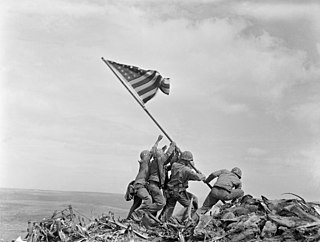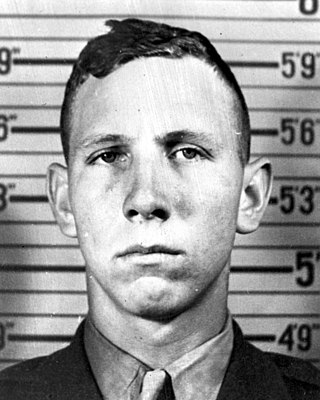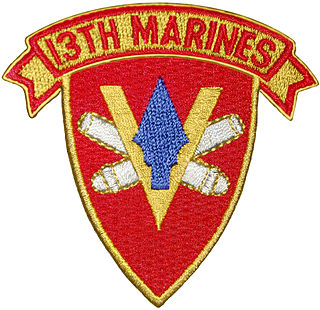
The Battle of Iwo Jima was a major battle in which the United States Marine Corps (USMC) and United States Navy (USN) landed on and eventually captured the island of Iwo Jima from the Imperial Japanese Army (IJA) during World War II. The American invasion, designated Operation Detachment, had the purpose of capturing the island with its two airfields: South Field and Central Field.

Ira Hamilton Hayes was an Akimel O'odham Indigenous American and a United States Marine during World War II. Hayes was an enrolled member of the Gila River Indian Community, located in Pinal and Maricopa counties in Arizona. He enlisted in the United States Marine Corps Reserve on August 26, 1942, and, after recruit training, volunteered to become a Paramarine. He fought in the Bougainville and Iwo Jima campaigns in the Pacific War.

Harlon Henry Block was a United States Marine Corps corporal who was killed in action during the Battle of Iwo Jima in World War II.

Michael Strank was a United States Marine Corps sergeant who was killed in action during the Battle of Iwo Jima in World War II. He was one of the Marines who raised the second U.S. flag on Mount Suribachi on February 23, 1945, as shown in the iconic photograph Raising the Flag on Iwo Jima by photographer Joe Rosenthal. Of the six Marines depicted in the photo, Strank was the only one to be correctly identified from the beginning; the other five were either assigned the wrong locations, or, were given the names of Marines who were not in the photo.

John Henry "Jack" "Doc" Bradley was a United States Navy Hospital corpsman who was awarded the Navy Cross for extraordinary heroism while serving with the Marines during the Battle of Iwo Jima in World War II. During the battle, he was a member of the patrol that captured the top of Mount Suribachi and raised the first U.S. flag on Iwo Jima on February 23, 1945.

The 5th Marine Division was a United States Marine Corps ground combat division which was activated on 11 November 1943 at Camp Pendleton, California during World War II. The 5th Division saw its first combat action during the Battle of Iwo Jima in 1945 where it sustained the highest number of casualties of the three Marine divisions of the V Amphibious Corps. The 5th Division was to be part of the planned invasion of the Japan homeland before Japan surrendered. Assault troops of the 5th Division were included in the Presidential Unit Citation awarded to the V Amphibious Corps for extraordinary heroism on Iwo Jima from 19 to 28 February 1945. The 5th Division was deactivated on 5 February 1946.

3rd Battalion, 25th Marines (3/25) is a reserve infantry battalion in the United States Marine Corps. The battalion was first formed in 1943 for service in the Pacific Theater of Operations during World War II, taking part in a number of significant battles including those at Saipan and Iwo Jima before being deactivated at the end of the war. In the early 1960s, the unit was reactivated as a reserve battalion. Currently headquartered in Brook Park, Ohio with units throughout Ohio, Tennessee, and Pennsylvania, the battalion is nicknamed "three deuce five" and consists of approximately 800 Marines and Sailors. They fall under the 25th Marine Regiment and the 4th Marine Division. Recent operations have included tours in Iraq and Afghanistan.

Tony Stein was a United States Marine who posthumously received the U.S. military's highest decoration, the Medal of Honor, for his actions in World War II. He received the award for repeatedly making single-handed assaults against the enemy and for aiding wounded Marines during the initial assault on Iwo Jima on February 19, 1945. He was killed in action ten days later.

The 28th Marine Regiment is an infantry regiment of the United States Marine Corps. The regiment, which is part of the 5th Marine Division, fought in the Battle of Iwo Jima during World War II. Six Marines of the 2nd Battalion, 28th Marines were featured in the historical photo by Joe Rosenthal of the U.S. flag raising on top of Mount Suribachi.

The 2nd Battalion, 28th Marine Regiment is an infantry battalion of the United States Marine Corps. The battalion which is part of the 28th Marine Regiment, 5th Marine Division, fought in the Battle of Iwo Jima during World War II. Six Marines of E Company, 2nd Battalion, 28th Marines were featured in the historical photo by Joe Rosenthal of the U.S. flag raising on top of Mount Suribachi.

Ernest Ivy "Boots" Thomas Jr. was a United States Marine Corps platoon sergeant who was killed in action during the Battle of Iwo Jima in World War II. He was awarded the Navy Cross for extraordinary heroism while fighting for and at the base of Mount Suribachi. Two days later he was a member of the patrol that captured the top of Mount Suribachi where he helped raise the first U.S. flag on Iwo Jima on February 23, 1945. He was killed eight days after that.
Harold George Schrier was a United States Marine Corps lieutenant colonel who served in World War II and the Korean War. In World War II, he was awarded the Navy Cross for leading the patrol that captured the top of Mount Suribachi, where he helped raise the first U.S. flag on Iwo Jima on February 23, 1945. In the Korean War, he was wounded in North Korea during the Battle of Chosin Reservoir while commanding a rifle company.

The 3rd Tank Battalion was an armor battalion of the United States Marine Corps. It was formed during World War II and played a part in several Pacific island battles, most notably Iwo Jima, where its flame tanks played a key role in securing the island. After the war, the battalion was based at Camp Pendleton but remained inactive until the outbreak of the Korean War, eventually moving to Okinawa. Along with the 1st Tank Battalion, 3rd Tanks was involved in major combat operations in South Vietnam from 1965 to 1969. Afterwards it concentrated on desert warfare and fought in the first Gulf War in 1991. It was deactivated for the last time in 1992.
Charles W. Lindberg was a United States Marine Corps corporal who fought in three island campaigns during World War II. During the Battle of Iwo Jima, he was a member of the patrol which captured the top of Mount Suribachi where he helped raise the first U.S. flag on the island on February 23, 1945. Six days later, he was wounded in action.

The 13th Marine Regiment was an artillery regiment of the United States Marine Corps. The regiment was activated for service three times during the 20th century when the Marine Corps expanded to meet war time requirements. Originally activated as an infantry regiment during World War I, the unit arrived in France before the war ended but did not participate in combat operations. It was reactivated for service in World War II as the artillery regiment for the 5th Marine Division. The unit saw intense combat during the Battle of Iwo Jima, participated in occupation duty in Japan and was quickly decommissioned shortly after the war. The regiment was last activated during the Vietnam War to again provide fire support for 5th Marine Division regiments supporting operations in South Vietnam. The regiment was finally deactivated on April 30, 1970, as the Marine Corps began to draw down its force structure at the conclusion of the Vietnam War.

Harold Henry Schultz was a United States Marine corporal who was wounded in action during the Battle of Iwo Jima in World War II. He was a member of the patrol that captured the top of Mount Suribachi and raised the first U.S. flag on Iwo Jima on February 23, 1945. He is also one of the six Marines who raised the larger replacement flag on the mountaintop the same day as shown in the iconic photograph Raising the Flag on Iwo Jima.
The 1st Battalion, 28th Marines (1/28) is an inactive infantry battalion of the United States Marine Corps. They were part of the 28th Marine Regiment and 5th Marine Division and fought during the Battle of Iwo Jima in World War II.

Fred Elmore Haynes Jr. was a United States Marine Corps major general who served in World War II and the Vietnam War. He completed his Marine Corps career as deputy chief of staff for Research, Development and Studies at Headquarters Marine Corps. He was the older brother of actor and Dallas television personality, Jerry Haynes aka Mr. Peppermint, and uncle of musician and artist Gibby Haynes.
Chandler Wilce Johnson was a highly decorated United States Marine Corps lieutenant colonel. He served as the commanding officer of 2nd Battalion, 28th Marines during the battle of Iwo Jima, leading his battalion in capturing Mount Suribachi which later led to the flag being raised over Iwo Jima. He was killed in action one week after the flag raising and was posthumously awarded the Navy Cross.
Dave Elliott Severance was a United States Marine Corps colonel. During World War II, he served as the commanding officer of Easy Company, 2nd Battalion, 28th Marines and led his company in the battle of Iwo Jima. During the battle, Severance ordered his 3rd Platoon to scale Mount Suribachi and raise the flag at the summit.















